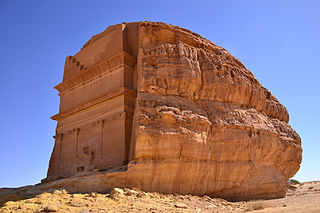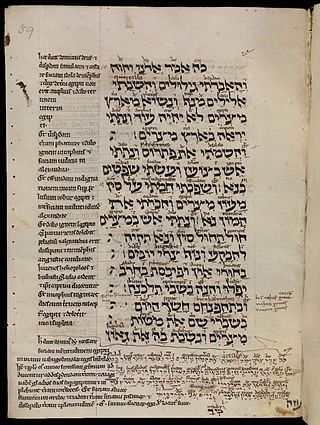Related Research Articles
Tarshish occurs in the Hebrew Bible with several uncertain meanings, most frequently as a place far across the sea from Phoenicia and the Land of Israel. Tarshish was said to have exported vast quantities of important metals to Phoenicia and Israel. The same place name occurs in the Akkadian inscriptions of Assyrian king Esarhaddon and also on the Phoenician inscription of the Nora Stone in Sardinia; its precise location was never commonly known, and was eventually lost in antiquity. Legends grew up around it over time so that its identity has been the subject of scholarly research and commentary for more than two thousand years.

Sheba is an ancient kingdom mentioned in the Hebrew Bible and the Quran. It particularly features in the tradition of Orthodox Tewahedo in today's Ethiopia and is also asserted as the home of the Queen of Sheba, who is left unnamed in Jewish texts, but is known as Makeda in Ethiopian texts and as Bilqīs in Arabic texts. According to the Jewish historian Josephus, Sheba was the home of Princess Tharbis, who is said to have been the wife of Moses before he married Zipporah.
Phut or Put is the third son of Ham, in the biblical Table of Nations. The name Put is used in the Bible for Ancient Libya, but a few scholars proposed the Land of Punt known from Ancient Egyptian annals.
Teman, was the name of an Edomite clan and of its eponym, according to the Bible, and an ancient biblical town of Arabia Petraea. The term is also traditionally used in Biblical Hebrew as the synonym of the direction South and was applied to being used as the Hebrew name of Yemen due to its location in the Southern end of the Arabian Peninsula, thus making Yemenite Jews being called "Temanim" in Hebrew.
Raamah is a name found in the Torah, meaning "lofty" or "exalted", and possibly "thunder".
Havilah refers to both a land and people in several books of the Bible; the one mentioned in Genesis 2:10–11, while the other is mentioned in Genesis 10:7.
Jokshan. According to the Bible he was a son of Abraham (Avraham) and his wife or concubine Keturah, whom he wed after the death of Sarah. Jokshan had five brothers: Zimran, Medan, Midian, Ishbak and Shuah; as well as two half brothers: Ishmael (Ismail) and Isaac (Ishaq). He was Keturah's second son and Abraham's fourth.
Lihyan, also called Dadān or Dedan, was a powerful and highly organized ancient Arab kingdom that played a vital cultural and economic role in the north-western region of the Arabian Peninsula and used Dadanitic language. The Lihyanites ruled over a large domain from Yathrib in the south and parts of the Levant in the north. In antiquity, the Gulf of Aqaba used to be called Gulf of Lihyan. A testimony to the extensive influence that Lihyan acquired. The term "Dedanite" usually describes the earlier phase of the history of this kingdom since their capital name was Dedan, which is now called Al-'Ula oasis located in northwestern Arabia, some 110 km southwest of Teima, both cities located in modern-day Saudi Arabia, while the term "Lihyanite" describes the later phase. Dadan in its early phase was "one of the most important caravan centers in northern Arabia". It is mentioned in the Hebrew Bible. The Lihyanites later became the enemies of the Nabataeans. The Romans invaded the Nabataeans and acquired their kingdom in 106 AD. This encouraged the Lihyanites to establish an independent kingdom to manage their country. This was headed by the King Han'as, one of the former royal family, which governed Al-Hijr before the Nabataean Expansion.

Al-'Ula is an ancient Arabic oasis city located in Medina Province, Saudi Arabia. Situated in the Hejaz, a region that features prominently in the history of Islam as well as several pre-Islamic Semitic civilizations, al-‘Ulā was a market city on the historic incense route that linked India and the Persian Gulf to the Levant and Europe.

Hegra, known to Muslims as Al-Hijr, also known as Mada’in Salih, is an archaeological site located in the area of Al-'Ula within Medina Province in the Hejaz region, Saudi Arabia. A majority of the remains date from the Nabataean Kingdom. The site constitutes the kingdom's southernmost and second largest city after Petra, its capital city. Traces of Lihyanite and Roman occupation before and after the Nabatean rule, respectively, can also be found.
Shuah is the name of one of four minor Biblical figures. It is sometimes used as the name of a fifth. Their names are different in Hebrew, but they were all transliterated as "Shuah" in the King James Version.
Ephah was one of Midian's five sons as listed in the Hebrew Bible. Midian, a son of Abraham, was the father of Ephah, Epher, Enoch, Abida, and Eldaah by his wife Keturah. These five were the progenitors of the Midianites.

The Land of Tema, Te'-ma or Tema Arabic: تيماء and Thaiman) is a place mentioned in the Bible where the descendants of Ishmael's son Tema dwelt. In Hebrew, the name means "south country". It was most likely in northern Saudi Arabia and has been identified with the modern Teima', an oasis which lies about 200 miles (320 km) north of Medina, and some 40 miles (64 km) south of Dumat (Dumah), now known as el-Jauf. Teima' is on the ancient caravan road connecting the Persian Gulf with the Gulf of Aqaba which in antiquity bought wealth to the town. Doughty has described at Teima the ruins of an old city wall 3 miles (4.8 km) in circuit. An Aramaic stele recently discovered, belonging to the 6th century BC, shows the influence of Assyrian in the town. The place is mentioned in the cuneiform inscriptions. The possibility of its being on a trade route is supported by the reference in Job 6:19. It is often associated with the Land of Dumah.
Isaiah 21 is the twenty-first chapter of the Book of Isaiah in the Hebrew Bible or the Old Testament of the Christian Bible. This book contains the prophecies attributed to the prophet Isaiah, and is one of the Books of the Prophets. This chapter contains prophecies against Babylon, Edom and Arabia.

Ezekiel 27 is the twenty-seventh chapter of the Book of Ezekiel in the Hebrew Bible or the Old Testament of the Christian Bible. This book contains the prophecies attributed to the prophet/priest Ezekiel, and is one of the Books of the Prophets. This chapter contains a lamentation for the fallen city of Tyre.

Ezekiel 38 is the thirty-eighth chapter of the Book of Ezekiel in the Hebrew Bible or the Old Testament of the Christian Bible. This book contains the prophecies attributed to the prophet/priest Ezekiel, and is one of the Books of the Prophets. This and the following chapter form a section dealing with "Gog, of the land of Magog".

Ezekiel 39 is the thirty-ninth chapter of the Book of Ezekiel in the Hebrew Bible or the Old Testament of the Christian Bible. This book contains the prophecies attributed to the prophet/priest Ezekiel, and is one of the Books of the Prophets. The previous chapter and verses 1-16 of this chapter form a section dealing with "Gog, of the land of Magog".

Since early modern times, a number of biblical ethnonyms from the Table of Nations in Genesis 10 have been used as a basis for classifying human racial and national identities. The connection between Genesis 10 and contemporary ethnic groups began during classical antiquity, when authors such as Josephus, Hippolytus and Jerome analyzed the biblical list.
References
- ↑ Brenton's Septuagint Translation: Isaiah 21
- ↑ Abarim Publications, The name Dedan in the Bible, accessed 7 April 2018
- ↑ Skinner, J., Cambridge Bible for Schools and Colleges on Isaiah 21, accessed 7 April 2018